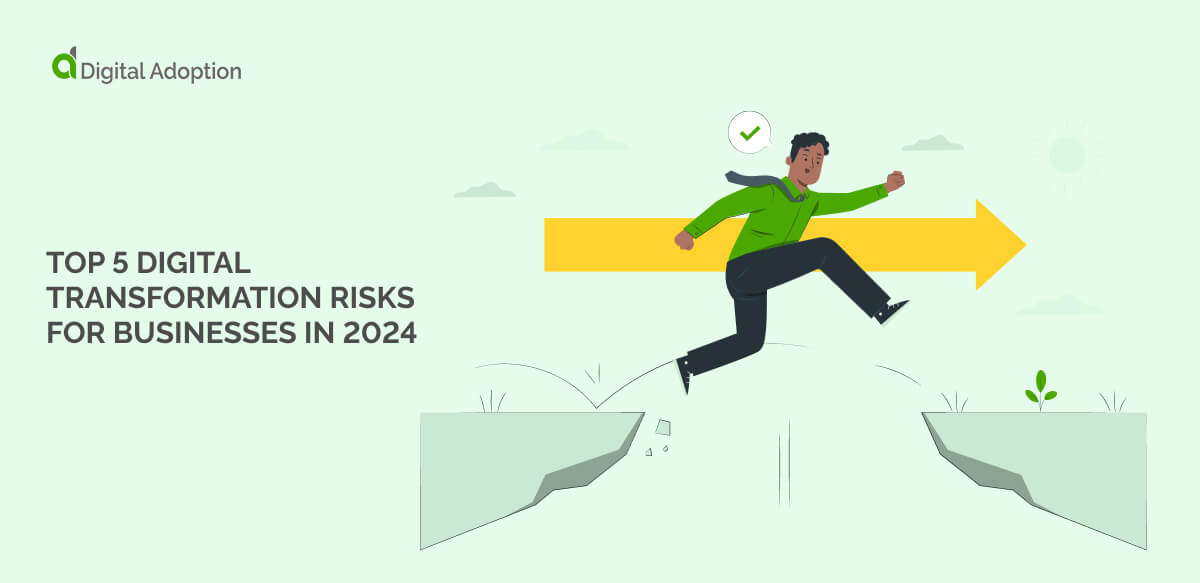Digital transformation has become a key focus for businesses across all industries in recent years.
As companies increasingly look to digitalize their operations and capture the value of nascent technologies, the potential benefits are vast – from increased IT efficiency and productivity to improved customer experiences (CX) and revenue growth.
However, before embarking on a digital transformation journey, businesses must first consider the risks associated with this complex process. Failure to do so can result in costly mistakes that can hinder progress and even damage a company’s reputation. According to McKinsey, when corporations launch transformations, roughly 70% fail.
One of the most significant risks is security. As organizations adopt new technologies and move more of their operations online, they become increasingly vulnerable to cyber-attacks. This risk can take many forms, including data breaches, ransomware attacks, rogue IT, and other malicious activity. Businesses must implement robust security measures to protect themselves and their customers from these threats, such as firewalls, encryption, and multi-factor authentication.
Cultural resistance is another risk that businesses must consider. Digital transformation requires a fundamental shift in mindset and behavior, which can be met with opposition from employees who resist change. To address this, businesses must develop effective change management strategies that provide ample education and support to employees throughout the transformation process.
This article will explore five top digital transformation risks for businesses, including security, cultural resistance, data privacy, vendor selection, and organizational complexity. By understanding these risks, companies can take proactive steps to protect themselves and ensure their transformations are successful.
Digital transformation risk areas
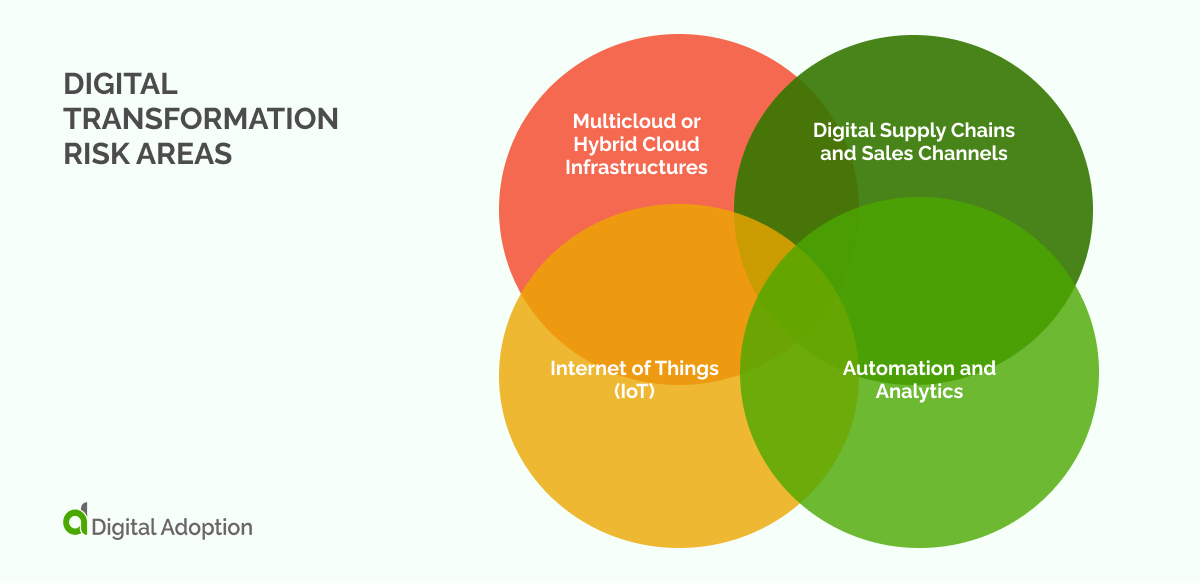
The importance of digital transformation will be firmly within the purview of business and IT decision-makers aiming to accelerate the speed of business and reaffirm a presence on the market.
In a 2023 Insights survey, 82% of respondents emphasized investing in digital transformation to avoid being left behind. Additionally, 49% identified keeping pace with technological innovation compared to competitors as one of the most significant threats to their organizations over the next twelve months.
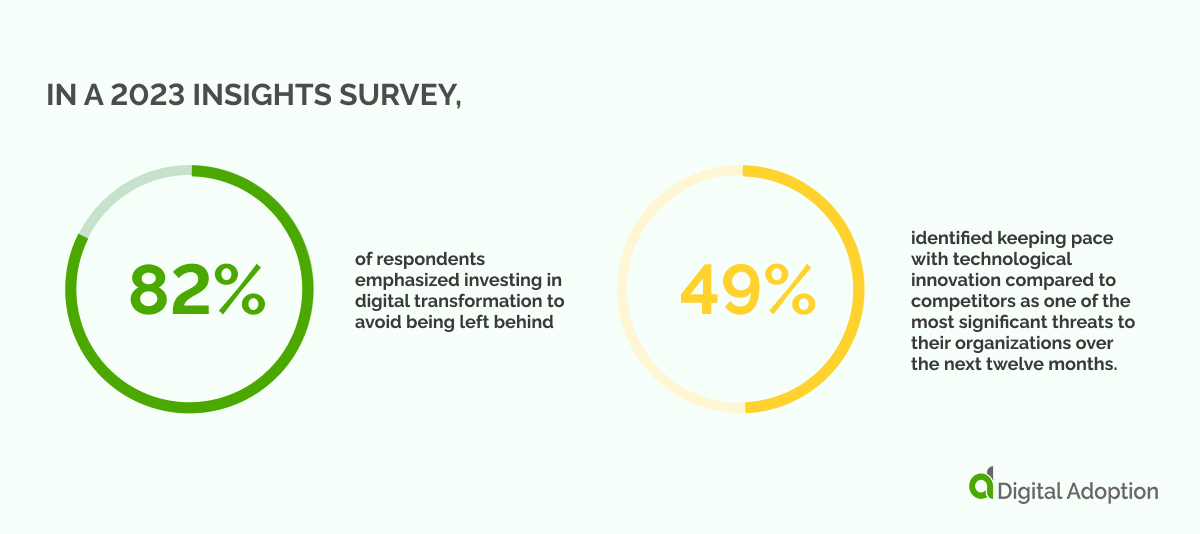
Yet, this shift may introduce unforeseen challenges. Here, we delve into some potential risk factors associated with digital transformation:
Multicloud or Hybrid Cloud Infrastructures
Many organizations are looking to multi-cloud and hybrid cloud infrastructures to give them the flexibility and agility they need for digital transformation. However, this shift can also introduce new risks, particularly when it comes to the governance of cloud environments.
Some of the most common risks include:
- Misconfiguration of security settings
- Insufficient detection
- Lack of response capabilities
- Lack of visibility into activity across virtual machines and cloud services
According to Statista, in 2021, 64% of survey participants identified data loss/leakage as their primary cloud security concern. Concerns regarding data privacy and confidentiality, along with unintentional exposure of credentials, ranked second and third, respectively.
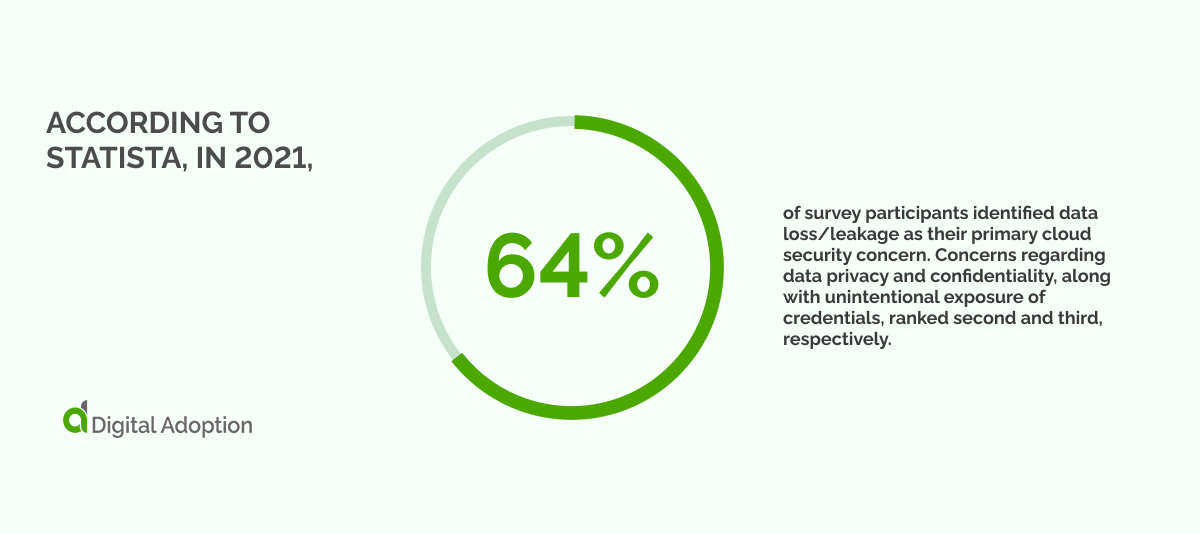
To address these risks, organizations need comprehensive governance frameworks that cover all aspects of their cloud deployments.
Digital Supply Chains and Sales Channels
The supply chain and sales channels can be one of the most vulnerable areas in digital transformation. A lack of clarity around a multichannel strategy can introduce several risks, such as disruptions in the supply chain and loss of business.
The OECD report that severe disruptions in global markets, resulting from Russia’s war on Ukraine, have revealed vulnerabilities in the supply of raw materials vital for industrial production and the transition to a greener economy.
Businesses should consider their digital transformation strategy to minimize risks and smooth the change transition.
Internet of Things (IoT)
The IoT is one of the most transformative technologies currently underway. According to research, the IoT market is anticipated to achieve a revenue of $1,177 billion by 2023. Automotive IoT stands out as the largest sector within the IoT industry, with its market volume projected to reach $397.20 billion in 2023.
By connecting physical objects to the internet, it has the potential to revolutionize the way we live, work, and play.
However, it also introduces a new set of risks, including:
- Denial-of-service attacks
- Entry points for hacking
- A tempting target for cybercriminals
To mitigate these risks, businesses must be mindful of the risks and take steps to ensure IoT technology’s safe and secure implementation.
Automation and Analytics
Analytics and automation technologies are critical components of digital transformation. However, poor-quality datasets and insufficient platforms can lead to poor performance.
Additionally, scaling and meeting expectations can lead to setbacks in deploying new analytics or AI models. To avoid these risks, businesses must invest in high-quality datasets and platforms that can handle the volume and complexity of data encountered in production.
The State of Automation in 2022 report by Blueprints Software System revealed that companies spend an average of $480K annually on automation. 40% of respondents reported using multiple RPA platforms for their automation needs. Additionally, Microsoft Power Automate was declared the most commonly used RPA execution tool, with 76% of respondents utilizing it. The departments that mostly own RPA in organizations are IT, Finance, and Accounting.
Top 5 digital transformation risks
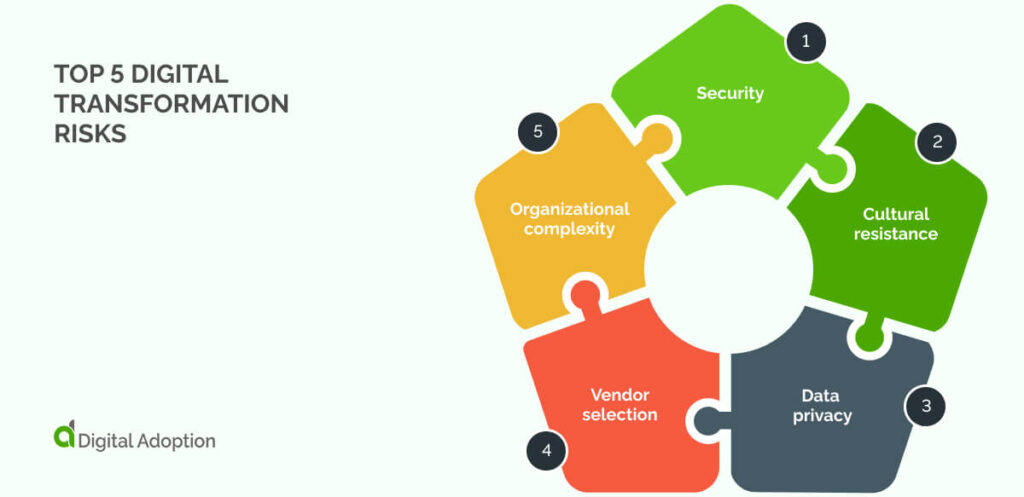
The digital transformation era is changing how businesses operate, with data obtained via WalkMe revealing, “The digital transformation market is projected to reach $1,009.8 billion by 2025.”
But with the adoption of new technologies, companies face potential risks that can impact their success. WalkMe’s research further supports this: “One in three CEOs failed to achieve the desired outcome from past transformation initiatives.”
These risks include security, cultural resistance, data privacy, vendor selection, and organizational complexity. We will go into more detail below:
1. Security
The digital transformation journey presents organizations with numerous benefits, including increased efficiency and productivity. However, it also exposes them to security risks that must be addressed before embarking on the digital transformation path.
One of the most significant security risks associated with digital transformation is the lack of employee awareness and understanding of the security risks involved in using digital tools. This makes it crucial for businesses to invest in comprehensive employee training programs highlighting the importance of security awareness and educating employees on identifying and managing potential threats.
Another significant security challenge is the use of cloud-based storage and applications. While the cloud offers several benefits, such as scalability, flexibility, and cost-effectiveness, we have already mentioned how it presents new security risks. Organizations must ensure they have proper cloud infrastructure security measures and that third-party vendors have robust security protocols to safeguard against data breaches.
Other security risks associated with digital transformation include using mobile devices, social engineering attacks, and emerging new forms of malware. According to Thales’ 2023 Data Threat Report, 47% of survey respondents noted increased attack volume or severity, similar to figures reported in 2021 and 2022. For those who witnessed a rise in attacks, 59% encountered more malware, 48% faced increased ransomware attacks, and 43% experienced more phishing attacks.
Organizations must adopt a comprehensive security strategy to mitigate these risks, including regular security assessments, employee training, network monitoring, and incident response planning.
2. Cultural resistance
The reluctance or resistance of employees to accept and adapt to new technologies and processes can create significant challenges for companies pursuing digital transformation. This resistance can result from fear of job loss, a lack of understanding of technological advancements, or an aversion to change.
The following steps can help address this issue:
Creating a Culture of Innovation: Organizations must create a culture that embraces innovation and change to overcome cultural resistance. They should foster an environment of openness, experimentation, and ongoing L&D.
Companies should encourage employees to develop new skills and knowledge through training, workshops, and other learning opportunities. Involving employees in planning and implementing digital transformation initiatives is also essential. This can help employees feel valued and invested in the project’s success.
Effective communication is key to overcoming cultural resistance. Companies must communicate why digital transformation is necessary and how it will benefit the organization and its employees. Communication should be clear, honest, and transparent.
Organizations should involve employees in the process and seek their feedback and ideas. This helps alleviate concerns and gain support for the project.
Training and Development: Providing opportunities for training and development can help employees understand new technologies and processes. Companies should offer training sessions, workshops, and other learning opportunities to help employees develop new skills and knowledge.
This can increase employee engagement and reduce the risk of cultural resistance.
Leadership Support: Leadership support is critical when implementing digital transformation initiatives. Leaders should be visible and actively engaged in the process. They should set the tone for the organization by modeling behavior that embraces change and innovation. This helps create a culture that supports digital transformation, reduces resistance, and increases the likelihood of success.
3. Data privacy
With the rapid growth in digital transformation, data privacy emerge as another critical concern for businesses.
Adopting new technologies such as cloud computing, machine learning, and IoT devices has enabled the capture and storage of massive amounts of sensitive data. Without proper safeguards, this can create significant risks for the business and its customers.
As per PwC’s Digital Trust 2023 Insights, 33% of senior executives in the UK anticipate a substantial increase in attacks against cloud management interfaces in 2023. Additionally, 20% of respondents expect a significant rise in attacks on the Industrial Internet of Things (IIoT) and operational technology (OT) over the next year.
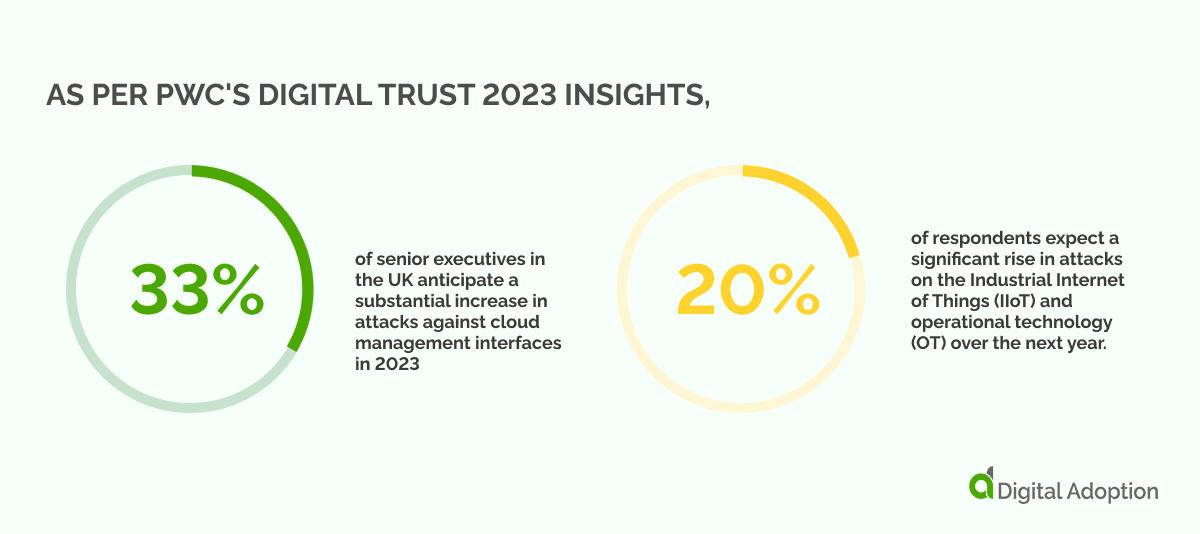
The risk of data breaches is higher than ever, with cyber-attacks becoming more sophisticated and frequent. Businesses must comply with various governance, risk, and compliance laws for data privacy, such as GDPR, CCPA, and HIPAA. These regulations set out stringent data handling, storage, and disposal requirements. Failure to comply with these regulations can result in hefty fines and penalties.
Moreover, companies should conduct regular security assessments and audits to proactively identify and address potential vulnerabilities. This can help ensure the organization’s data is secure and complies with relevant regulations.
4. Vendor selection
Selecting the right vendor is integral to any successful digital transformation initiative.
A reliable vendor can help businesses to achieve their strategic objectives, streamline operations, reduce costs, and enhance customer experience. On the other hand, selecting the wrong vendor can lead to many problems, such as wasted resources, project delays, and even project failure.
When selecting a vendor, ensuring they have the necessary technical expertise is crucial. This means they should possess the relevant software, skills, knowledge, and experience to complete the project successfully. A seasoned vendor can anticipate potential problems and offer solutions aligning with the business objectives.
Businesses should ensure the vendor understands their industry, business processes, and regulatory environment deeply. This knowledge is essential in identifying opportunities, addressing challenges, and providing insights to drive digital innovation and growth.
It’s also essential to take into account their reputation and pricing model. Conducting due diligence, such as checking references, reviewing case studies, and conducting background checks, can help ensure that the vendor has a proven track record of delivering quality products and services on time and within budget.
Ensure the vendor’s pricing model is transparent, reasonable, and competitive. A detailed breakdown of costs, including any additional expenses associated with the project, should be provided upfront. Scalability is also a key consideration when selecting a vendor.
Businesses must ensure the vendor can accommodate their growing needs as they scale up. The vendor should have the resources and flexibility to adapt to changing business requirements and provide ongoing support and maintenance services.
Finally, support and maintenance services should be a key consideration when selecting a vendor. The vendor should be able to provide timely and reliable support for any questions or issues that may arise. This is essential for ensuring a successful partnership and mitigating potential risks in vendor selection.
5. Organizational complexity
Organizational complexity is another significant risk factor in digital transformation and rounds off our list of the top five digital transformation risks for businesses In 2023.
Implementing new technologies can lead to complications and disruptions of existing processes, systems, and structures, which can cause delays and cost overruns.
McKinsey conducted a survey that found that companies with low levels of complexity, where it is easy to get things done, had the highest returns on capital employed and invested. Moreover, 80% of organizations that reduced complexity saw reduced costs. In comparison, some even achieved savings of nearly 20% on personnel expenses by eliminating activities that create complexity but add little value.
Here are some essential points to keep in mind when assessing the risk of organizational complexity in digital transformation:
- Evaluate the organization’s current state: assess the strengths and weaknesses of existing processes, systems, and structures.
- Identify the desired outcome: determine what improvements the organization aims to achieve with the digital transformation.
- Analyze the impact: assess how the digital transformation will impact the organization’s existing processes, systems, and structures.
- Develop a strategic plan: create a detailed plan of action that addresses the risks identified in the assessment and outlines how to mitigate them.
- Communicate the plan: ensure that the goal is communicated effectively across all relevant stakeholders, including employees, partners, and vendors.
Organizations should follow these steps to minimize the impact of organizational complexity during digital transformation and ensure the successful adoption of new technologies. It is important to create a change management plan that outlines the necessary actions for handling resistance to change and providing a seamless implementation.
Avoiding digital transformation risks: becoming a truly digital-first organization
Becoming a truly digital-first organization is essential in avoiding the risks associated with digital transformation. Embracing digital technologies and incorporating them into every aspect of the business can lead to increased efficiency, innovation, and growth.
The COVID-19 pandemic caused disturbances in the labor and supply markets, while geopolitical risks rose due to the Russian invasion of Ukraine. This all works to confirm one thing – change is increasingly fast and disruptive – further emphasizing the need for effective risk management.
However, as organizations undergo digital transformation (DX), the byproducts can lead to complex capabilities that require a careful balance of risk and innovation. Every vertical of personnel must navigate these challenges, from executives to entry-level employees.
When done right, the rewards of DX can lead to an expansion of organizational capabilities, including optimizing business models, introducing new technologies, and integrating data-driven decision-making processes. However, as we mentioned, complexities, e.g., cybersecurity risks, compliance issues, and rapid changes in market conditions, must first be managed.
Organizations must cultivate education and collaboration among their people to succeed in this feat while embracing agility and resilience as core values.

